Introduction
Personal injury cases often involve complex questions of liability. One common concern for victims is whether they can file a claim if they were partially responsible for the accident. The answer depends on the laws in the state where the accident occurred and the degree of fault assigned to each party.
Understanding how fault is determined, the legal doctrines involved, and how comparative negligence affects compensation is crucial to navigating your personal injury claim effectively.
Understanding Fault in Personal Injury Cases
Fault in a personal injury case refers to the legal responsibility of a party for causing harm. Determining fault typically involves proving the following elements:
- Duty of Care: The defendant had a legal duty to act in a certain manner to prevent harm.
- Breach of Duty: The defendant failed to fulfill this duty through negligent actions or omissions.
- Causation: The defendant’s breach of duty directly caused the plaintiff’s injuries.
- Damages: The plaintiff suffered losses due to the injury, such as medical bills, lost wages, and emotional distress.
Legal Theories of Fault: Comparative and Contributory Negligence
When a plaintiff is partially at fault for an accident, different legal doctrines apply depending on the jurisdiction:
1. Comparative Negligence
Many states follow comparative negligence rules, which allow an injured party to recover damages even if they were partially at fault. There are two main types:
- Pure Comparative Negligence: Under this system, you can recover damages even if you are 99% at fault, but your compensation is reduced in proportion to your percentage of fault. For example, if your damages total $100,000 and you are found 40% at fault, you can still recover $60,000.
- Modified Comparative Negligence: This rule sets a threshold (usually 50% or 51%). If your fault is below the threshold, you can recover damages, but if your fault is equal to or greater than the threshold, you are barred from recovering any compensation.
2. Contributory Negligence
Some states follow the contributory negligence rule, which is much stricter. Under this system, if you are found even 1% responsible for the accident, you cannot recover any damages. This rule is applied in only a few states, such as Maryland, Virginia, Alabama, and North Carolina.
How Partial Fault Affects Compensation
The amount you receive in a personal injury claim depends on your level of fault. Here’s how different negligence systems affect compensation:
| Negligence Rule | If You Are 20% at Fault | If You Are 50% at Fault | If You Are 80% at Fault |
|---|---|---|---|
| Pure Comparative | 80% of damages awarded | 50% of damages awarded | 20% of damages awarded |
| Modified Comparative (50% Rule) | 80% of damages awarded | 50% of damages awarded | No compensation |
| Modified Comparative (51% Rule) | 80% of damages awarded | No compensation | No compensation |
| Contributory Negligence | No compensation | No compensation | No compensation |
Proving Your Case When You Are Partially at Fault
If you are partially responsible for an accident but still want to file a claim, you must build a strong case to minimize your percentage of fault. Here’s how:
1. Gather Strong Evidence
- Photographs and Videos: Capture images of the accident scene, damages, and injuries.
- Eyewitness Testimonies: Statements from people who saw the accident can support your version of events.
- Police Reports: Official accident reports may help clarify who was at fault.
- Medical Records: Documentation of your injuries can establish the extent of harm suffered.
2. Work with an Experienced Personal Injury Attorney
A lawyer can help you:
- Negotiate with insurance companies to reduce your fault percentage.
- Challenge unfair accusations that increase your fault level.
- Present expert witness testimony to support your claim.
3. Avoid Admitting Fault
Even a simple apology at the scene can be used against you. Let investigators determine liability based on facts.
4. Be Cautious with Insurance Companies
Insurance adjusters may try to shift more blame onto you to reduce their payout. Avoid making recorded statements without legal advice.
Real-Life Scenarios Where Partial Fault Applies
Here are a few common situations where an injured party may share some fault:
- Car Accidents: A driver is rear-ended but was also distracted by their phone.
- Slip and Falls: A store failed to clean up a spill, but the victim was walking while looking at their phone.
- Pedestrian Accidents: A pedestrian crosses outside a crosswalk, but the driver was speeding.
In these cases, victims may still recover compensation depending on their state’s negligence laws.
Conclusion
Yes, you can file a personal injury claim even if you were partially at fault, but the amount you recover depends on your state’s negligence laws. Understanding comparative and contributory negligence is crucial to determining your eligibility for compensation.
To maximize your recovery, gather strong evidence, consult a personal injury attorney, and avoid actions that could increase your assigned fault percentage. Knowing your rights and legal options ensures you receive the compensation you deserve, even if you share some responsibility for the accident.
If you’ve been injured and have questions about your eligibility to file a claim, consult an experienced personal injury attorney to assess your case and protect your rights.




